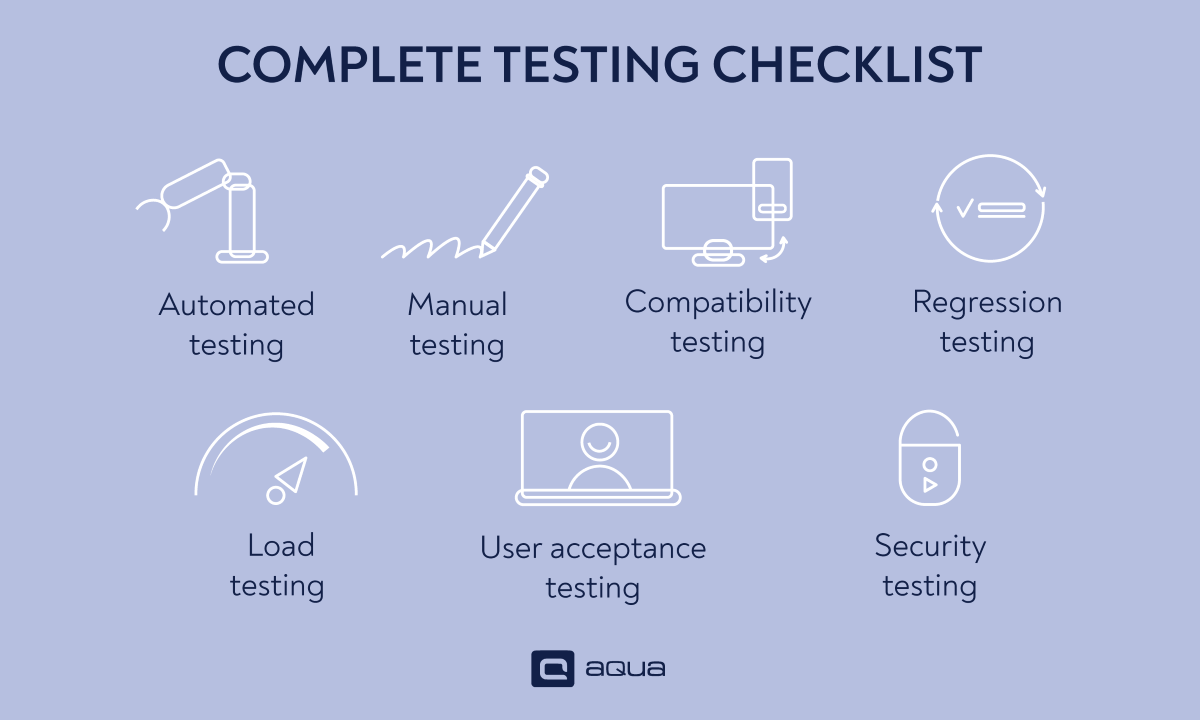If you are nodding your head in agreement, then you understand the pain of trying to deliver high-quality software under pressure. From managing project timelines to juggling multiple tasks simultaneously, the whole process can be overwhelming and lead to delays in software releases.
But it does not have to be that way. With the right approach, you can deliver the high-quality product your users want in time. It starts with one question: what do I do wrong?
In this article, we will discuss the “seven deadly sins” that cause delays in your software launch and advice to avoid them.
Additionally, we explored other mistakes that can derail software releases in the video.
#1. Inadequate planning
Poor planning is one of the leading causes of software release delays. Many development teams fail to adequately plan projects with proper budget and deadline estimation. To avoid this mistake, it is vital to create a project plan that includes the following:
- Budgets — Determine the project budget and allocate resources appropriately to avoid overruns and financial issues.
- Timelines — Consider the proper time required for each stage of the project to develop a clear and reasonable timeline for it.
- Resources — Ensure the team can access all the necessary resources, including hardware, software, and personnel.
- Milestones — Create milestones throughout the project’s lifecycle to measure progress. It will help you keep track of the progress too.
With regular planning and reviewing, you can ensure that the project plan is relevant and up-to-date with the changes made to it. Implementing the tips mentioned above makes it easier to eliminate the inadequate planning issue and release the software on time and within the estimated budget.
#2. Poor communication
Proper communication is needed in every team project. If you do not want to see your software release delayed, you should establish excellent communication between the team members. Poor communication will lead to misunderstandings and delays affecting the software quality.
To avoid these mistakes, you should do the following:
- Regular contact: Developers must communicate regularly with each other and the stakeholders to ensure everyone is on the same page. Communication should be ongoing and not limited to specific parts of the project. It is also crucial to ensure everyone understands how the communication channels work and use them properly.
- Proper goals and requirements: The team’s priority should be making sure everyone understands the project requirements and goals. That makes working toward the same goal easier and leaves no room for misunderstanding about what is expected.
- Timelines: It is also crucial that all team members know their timelines and deadlines and follow them. If team members miss the deadline, they should communicate the reason properly so the timelines can be changed.
Effective communication requires all team members’ commitment, and lack of communication is one of the leading reasons for software release delay decisions. So you should always ensure that everyone is on the same page, trying their best to meet the deadlines, and understands the project’s goals and requirements.
#3. Incomplete testing
Inadequate testing is another crucial reason that may cause a software release delay. Software testing is vital to developing a high-quality end product meeting users’ expectations.
In most cases, incomplete testing leads to an end product with many bugs and issues. To avoid this mistake, it is crucial to develop a comprehensive testing plan that includes the following:
- Automated testing — Use automated bug reporting tools to identify bugs faster and more efficiently. They can help you cover a broad range of scenarios and help you with repetitive tasks.
- Manual testing — Conduct manual testing to cover what might be missed in the automated testing.
- Compatibility testing — Test the software in different environments and scenarios to know how it operates on different operations systems and devices.
- Regression testing — Perform regression testing to ensure the software works well after new changes.
- User acceptance testing — Conduct user acceptance testing to ensure the final product meets the end user’s expectations.
- Load testing — Test the software under heavy loads to see how it performs with many users and transactions.
- Security testing — Ensure the software is 100% safe and fully protects the users’ data. Test for vulnerabilities, authentication, and access controls.

"Never allow the same bug to bite you twice."
Before release, you should ensure that your software is free of bugs and vulnerabilities and that all issues are resolved. Creating a comprehensive testing plan that includes all the testing types mentioned above will help you with it. A test management solution can minimise your efforts by eliminating repetitive tasks and increasing your overall efficiency.
aqua helps you manage the whole testing process effortlessly
#4. Feature creep
Feature creep is a phenomenon where the dev team adds new features to the software without considering the impact on the timeline and budget. It causes cost overruns and, in some cases, software release delays decisions. To avoid this, you should do the following:
- Stick to the original scope: Avoid adding features and functionalities that were not mentioned in the original scope.
- Establish precise requirements: Define the requirements and scope clearly, including features and functionalities.
- Evaluate new features: Evaluate new feature requests carefully and estimate their effects on the project’s budget and timeline. Only accept requests that align with the project’s goals.
Sticking to the original scope and evaluating new feature requests will help you avoid feature creep and finish the software within the defined scope.
#5. Unrealistic timelines
Unrealistic timelines are another reason for software release delays. Sometimes, developers set overly ambitious timelines that do not align with reality. It leads to missed deadlines and rushed development. To avoid this, the dev teams should do the following:
- Consider available resources: First, understand your team’s skills, experience and workload alongside available tools and technology.
- Evaluate the project’s scope and complexity: Assess the scope and complexity of the project, including the requirements, technologies, and development methods.
- Collaborate with your team: Involve your team in timeline creation, and identify potential areas of improvement where additional resources may be required.
These simple steps will help you develop a realistic timeline for the project where the expectations are just right and no one is under tight deadlines.
#6. Poor resource allocation
Improper resource allocation can also lead to a software release delay. It happens when the developers cannot access necessary resources, including software and hardware. To avoid this, you need to:
- Identify required resources: Know the needed resources, including hardware, software, network, and other tools required for testing and development.
- Allocate resources efficiently: Ensure that resources are allocated efficiently and consider the team’s workload and timelines.
- Monitor resource usage: Ensure that the resources are used effectively and efficiently, and keep track of the resource usage.
Following these steps will allow you to ensure that the resources are allocated well and used most efficiently in the project.
#7. Inadequate documentation
Poor documentation can also lead to delays in a software release because it makes it unclear for developers to understand the codes and make changes to them. You can fix it with several steps:
- Create comprehensive documentation: Develop detailed documentation explaining the code’s purpose, design, and functionality.
- Update documentation regularly: Ensure documentation is updated throughout the project’s lifecycle and reflects the changes made to the code.
- Use clear and consistent language: Ensure everyone understands the documentation.
- Make documentation accessible: Documentation should be easily accessible, so ensure everyone can access it.
These simple steps will help you deal with inadequate documentation issues, and you will be able to eliminate a potential reason that might lead to a software release delay.
#8 Scope creep
Scope creep occurs when the project’s initial scope keeps expanding without proper control, leading to increased work, time, and resources needed, which can ultimately delay the software release. It’s like a project constantly growing beyond its intended boundaries, causing strain on the team and budget. Here is how you should deal with this challenge:
- Clear Project Scope: Define the project scope clearly and thoroughly from the start.
- Robust Change Control: Establish a change control process to assess and approve any alterations to the scope.
- Regular Evaluation: Continuously assess proposed changes against the defined scope.
- Stakeholder Alignment: Ensure stakeholders are aligned with and understand the agreed-upon project scope.
- Documentation: Document and communicate any scope changes to maintain transparency and accountability.
By maintaining a disciplined approach to managing changes in the project scope, you can minimise the risk of scope creep and better control the project’s direction, ensuring a more timely and efficient software release.
#9 Technical debt accumulation
Technical debt accumulation occurs when development teams prioritise speedy delivery over code quality. When technical debt starts piling up, it’s like you’re taking out a loan with a high-interest rate. You’re rushing to get things done, but that speedy delivery comes at a cost. Your code quality suffers, leading to issues that need fixing. It slows you down, makes future work harder, and eats up extra time for maintenance and improvements. But you can deal with it, and here is how:
- Prioritise Your Code Quality: Focus on writing clean, well-structured code instead of just racing to meet deadlines.
- Allocate Time for Refactoring: Set aside moments to clean up and improve existing code without adding new features.
- Embrace Agile Practices: Use agile methods to tackle technical debt gradually throughout your development process.
- Educate and Raise Awareness: Teach your team about the importance of maintaining code health and the consequences of accumulating technical debt.
- Balance Your Speed and Quality: Find that sweet spot between fast delivery and keeping your code in good shape to prevent racking up more technical debt.
By taking these steps, you’ll manage technical debt proactively, ensuring that your code remains healthy and manageable while meeting your project deadlines.
#10. Ineffective change management
Change management is the structured approach and processes employed to manage an organisation’s people side of change. It involves preparing, supporting, and helping individuals and teams adapt to new processes, technologies, or shifts in the organisational structure.
When you don’t handle change within a project well, it’s like navigating rough waters without a map. Mismanaged changes disrupt workflows, causing confusion, delays, and sometimes even derailing the software release. This inefficiency leads to the rework of wasted resources and compromises the project’s success. Here is the step-by-step solution:
- Establish a Formal Change Process: Create a structured method for evaluating, approving, and implementing changes.
- Clear Communication: Ensure everyone involved understands and follows the change management process.
- Assess Impact: Evaluate the potential effects of proposed changes on timelines, resources, and objectives.
- Involve Relevant Stakeholders: Engage all necessary parties in decision-making to mitigate resistance or misunderstandings.
- Documentation and Tracking: Document all changes and their outcomes for future reference and learning.
By implementing these strategies, you can navigate changes more effectively, minimising disruptions and steering the project toward success despite evolving requirements.
#11. Lack of stakeholder feedback/involvement
Not involving stakeholders or gathering their feedback is the next mistake on our list because it creates misunderstandings and can lead to a product that doesn’t meet their needs. To tackle this, involve stakeholders from the start and keep them engaged throughout the project.
Actively seek their input, understand their requirements, and communicate regularly to align project goals with their expectations. This ensures a clearer understanding of needs, minimises mistakes, and increases the likelihood of delivering a product that satisfies stakeholders.
#12. Inefficient risk management
One of the costly challenges that delay software release is inadequate risk management. When you overlook identifying and mitigating risks within your project, it sets the scene for unexpected hurdles that can impact your timelines, exceed your budget, and demand extensive reworking. These unmanaged risks disrupt your schedules and financial plans, potentially compromising the quality and reliability of your final product. Here is how you can avoid this:
- Thorough Risk Assessment: Conduct comprehensive risk assessments at project initiation and throughout the lifecycle.
- Risk Mitigation Plans: Develop plans to mitigate identified risks, proactively allocating resources to address potential issues.
- Continuous Monitoring: Regularly review and reassess potential risks to anticipate and manage them effectively.
- Adaptability and Contingency: Build contingency plans to address unforeseen risks and adapt to changing circumstances.
These steps will help you prevent this costly mistake, helping you better navigate uncertainties, minimise disruptions, and ensure smoother project progress.
#13. Dependencies mismanagement
The next issue on our list is with dependencies. Dependency mismanagement occurs when different parts of your project rely on one another, and if you’re not keeping track, it’s easy for things to fall out of sync. This could be between modules, teams, or even external factors. When these dependencies are overlooked or managed poorly, it can disrupt the workflow, leading to delays and hindering progress. It’s like a chain reaction—if one part is delayed or affected, it impacts the rest.
To address this, start by identifying these interconnections early in your project. Document them clearly so everyone understands how each part relies on the others. This helps set up a clear communication channel, ensuring everyone knows about these dependencies and their potential impact. Additionally, contingency plans allow smoother navigation around potential disruptions caused by these dependencies.
#14. Team burnout
Now it is time for a lesser-discussed but at least equally crucial problem: team burnout. When your team experiences burnout or high turnover rates, it’s like working against yourselves because no matter how hard you try, the results do not improve. Overworked or departing team members lead to decreased productivity, knowledge loss, and potential delays in project timelines. To deal with it, you must prioritise your team’s well-being by fostering a supportive work environment, addressing their concerns, maintaining a healthy work-life balance, and ensuring a supportive culture. This maintains productivity and sustains motivation, preventing knowledge loss and delays in project completion.
Conclusion
Software release delays can be frustrating and time-consuming, but you can avoid them by implementing the abovementioned steps. You should ensure the project is adequately planned, documented, and communicated. Good software development is more than just coding; it is about careful planning, communication, and collaboration to deliver a high-quality product.
And never forget about a proper testing plan; complete testing will set your software up for success.
With aqua, you can manage your testing cases from one place in a customisable, easy-to-understand dashboard






